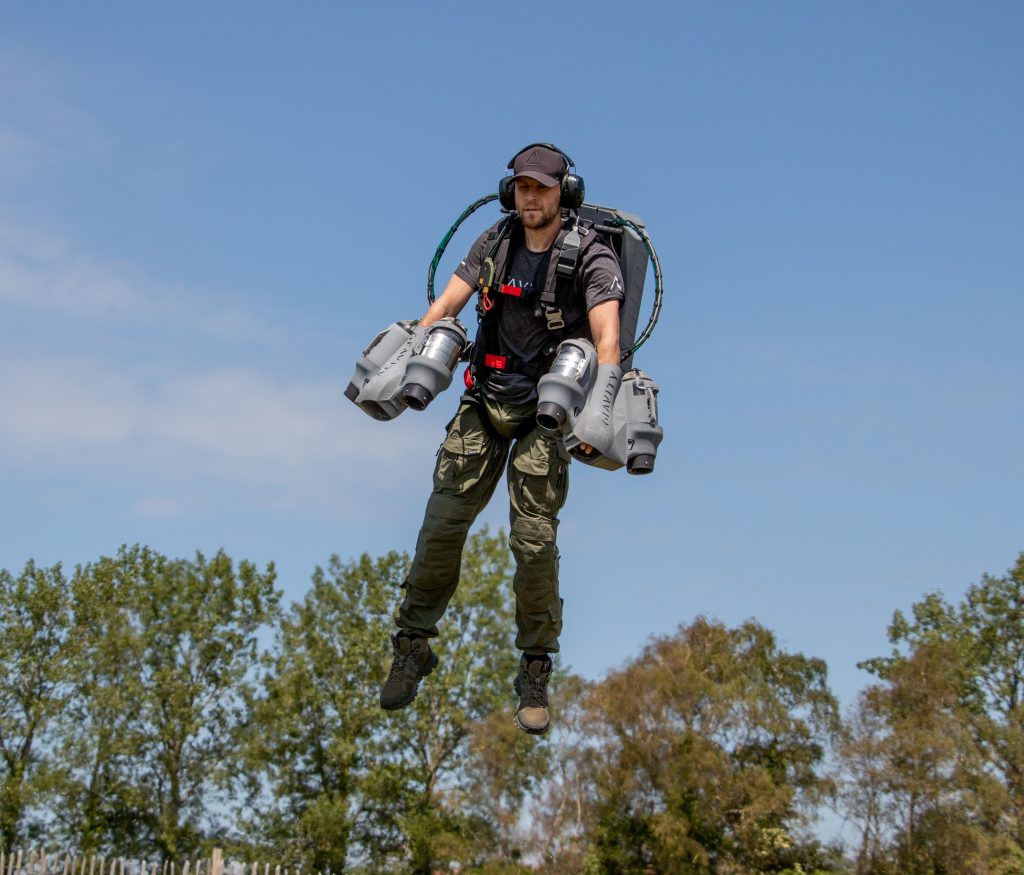Introduction
Harnessing RICOH’s global manufacturing and innovation expertise, Ricoh 3D empowers its customers through 3D printing and bespoke end-to-end additive manufacturing (AM) solutions, to create added value.
Ricoh 3D supports RICOH’s global mission-vision; to empower individuals to find Fulfilment through Work by understanding and transforming how people work so we can unleash their potential and creativity to realise a sustainable future.
And what greater Fulfilment through Work than achieving the world’s first superhuman flight!
History
From humble beginnings to a multi-dollar organisation with a multitude of opportunities across sectors… Introducing Gravity Industries.
Founder, Richard Browning, spent 16 years in the oil industry working for BP in London and alongside, spent six years in the Royal Marine Reserve. But actually, in hindsight, his inspiration for the Jet Suit was derived from his childhood, growing up around his aeronautical engineer father, tinkering in his workshop and flying model gliders with him.
In 2016, Richard’s experimental build process began. In his evenings and weekends, Richard bought his first jet engine and then advanced through endless prototyping attempts before achieving the first flight in November 2016.

Over the next six months the system was further refined, and sponsorships were attained, enabling Gravity Industries to officially launch in April 2017. The business soon secured investment funding of $650,000 and so, Richard began collaborating with a number of manufacturing specialists, including Ricoh 3D.
And it was Ricoh 3D’s polypropylene which helped bring Richard’s dream of ‘superhuman’ flight into reality!
Click here to read the full story.

Gravity’s decision to work with Ricoh 3D stemmed from their desire to build jet suits that blend mind, body, and machine, which ultimately required a material that mimicked organic matter and would enable a flight experience that was both comfortable and safe. Ricoh 3D’s flagship material, polypropylene, ticked every box.
The rest is history… Fast forward to today – a dedicated team of over 30 diverse and talented individuals across continents, over 105 live flight events in 31 countries, a Search and Rescue pilot project with Great North Air Ambulance (GNAA), an International Race Series and more. Who said people can’t fly?








Application
With multiple bespoke application parts, iterations, customisable Jet Suits (the list goes on!), in the latest partnership, Gravity sought the expertise of Ricoh 3D once more to enhance their existing jetpack design, and improve sustainability, by reducing weight – without compromising on strength. In short, Gravity aimed to eliminate unnecessary material to improve performance and efficiency.

After conducting a thorough ‘Discover’ phase – a part of Ricoh 3D’s ‘Discover Transform Sustain’ approach to business, Gravity Industries and Richard Browning were intrigued by the use of isogrid surface latticing, a solution powered by optimisation software, known for producing high stiffness and lightweight components, commonly applied in aerospace applications.
Once again, following their motto, they dared to ask, “what if?”
Solution
With a customer-centric approach, Ricoh 3D Junior Engineer, Charlie Kelsey led the optimisation stage, utilising nTop software – the most powerful additive manufacturing design software, employed by professionals enabling some of the world’s most innovative products.
Specifically, Charlie harnessed the software capabilities to create triangular honeycombs on cell maps from the jetpack’s internal ‘faces’. These honeycombs featured variable thickness beams, ensuring maximum strength near the vertices of the suit.



Speaking of the optimisation process, Charlie said: “By adopting the triangular honeycomb approach, not only did this ensure high amounts of weight reduction, but it also kept the structural integrity of the jetpack – ensuring maximum safety for the operator.
“The features and capabilities of nTop significantly helped achieve this, using their implicit modelling tools. I thoroughly look forward to conducting more optimisations like this in future projects with Gravity – as well as with our other partners and customers.”
Results
In brief, this innovative design resulted in a total weight saving of over 15%, significantly enhancing the jetpack’s performance and efficiency, thus making it more sustainable.

Testimonial
In a previous interview, Gravity’s Founder, Richard Browning said: “Our partnership with Ricoh 3D has shown that anything is possible when you blend together entrepreneurship and technological innovation.
“We’ve built up an amazing global footprint since 2017, and RICOH has enabled us to transform an ‘impossible’ idea into something viable for production.”

Ricoh 3D’s Mark Dickin, Head of Additive Manufacturing, added: “All of the jet suits, including this latest model, are a testament to the tenacity of engineering, and as Richard says, ‘a blend of mind, body and machine’.”
“Initially, by pushing the boundaries with both 3D printing and polypropylene, we showcased expertise and ingenuity – but importantly, sustainability too! Polypropylene is 90% recyclable, lightweight and flexible while still being incredibly durable – ideal for taking to the skies.
“Now, with this latest project, we have been pleased to support Gravity in further lightweighting their jetpacks through design optimisation.
“In this particular application, the innovative use of isogrid latticing has been pivotal in achieving our shared design goals. Moreover, the weight reduction has vastly improved the jetpack’s performance.
“Richard and the team are pushing the boundaries of what we think humans are capable of, so we’re delighted to have played a part in this and look forward to continuing our partnership, as we look to support more sustainable components and applications.”
